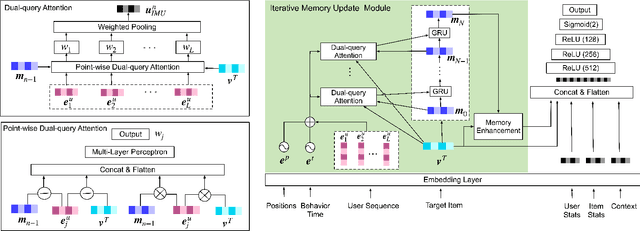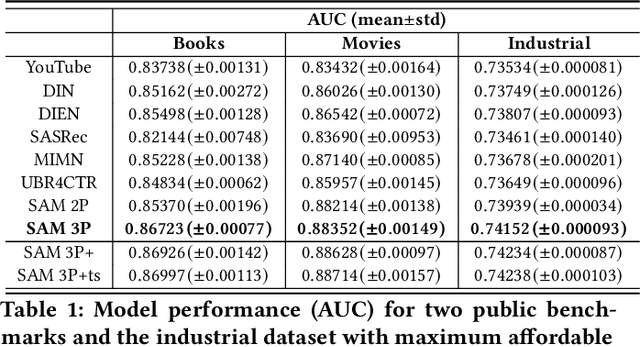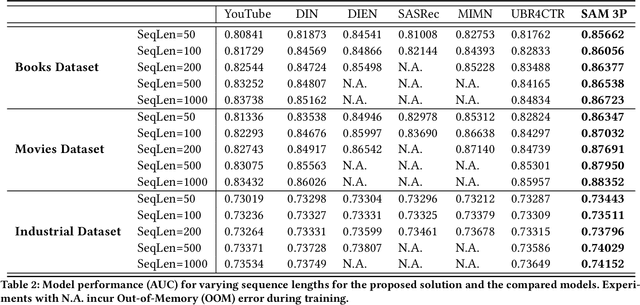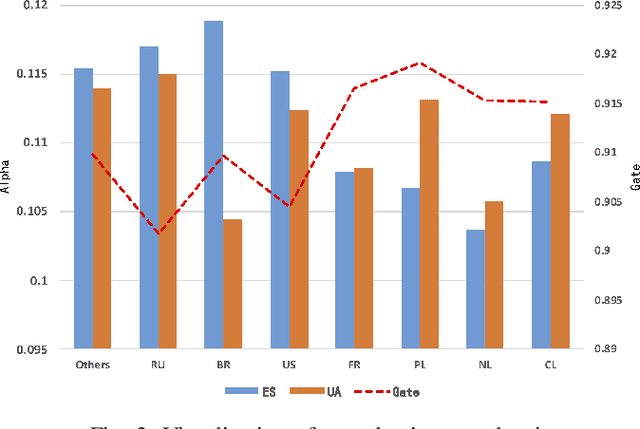Yanshi Wang
Sparse Attentive Memory Network for Click-through Rate Prediction with Long Sequences
Aug 08, 2022



Abstract:Sequential recommendation predicts users' next behaviors with their historical interactions. Recommending with longer sequences improves recommendation accuracy and increases the degree of personalization. As sequences get longer, existing works have not yet addressed the following two main challenges. Firstly, modeling long-range intra-sequence dependency is difficult with increasing sequence lengths. Secondly, it requires efficient memory and computational speeds. In this paper, we propose a Sparse Attentive Memory (SAM) network for long sequential user behavior modeling. SAM supports efficient training and real-time inference for user behavior sequences with lengths on the scale of thousands. In SAM, we model the target item as the query and the long sequence as the knowledge database, where the former continuously elicits relevant information from the latter. SAM simultaneously models target-sequence dependencies and long-range intra-sequence dependencies with O(L) complexity and O(1) number of sequential updates, which can only be achieved by the self-attention mechanism with O(L^2) complexity. Extensive empirical results demonstrate that our proposed solution is effective not only in long user behavior modeling but also on short sequences modeling. Implemented on sequences of length 1000, SAM is successfully deployed on one of the largest international E-commerce platforms. This inference time is within 30ms, with a substantial 7.30% click-through rate improvement for the online A/B test. To the best of our knowledge, it is the first end-to-end long user sequence modeling framework that models intra-sequence and target-sequence dependencies with the aforementioned degree of efficiency and successfully deployed on a large-scale real-time industrial recommender system.
Scenario-aware and Mutual-based approach for Multi-scenario Recommendation in E-Commerce
Dec 16, 2020



Abstract:Recommender systems (RSs) are essential for e-commerce platforms to help meet the enormous needs of users. How to capture user interests and make accurate recommendations for users in heterogeneous e-commerce scenarios is still a continuous research topic. However, most existing studies overlook the intrinsic association of the scenarios: the log data collected from platforms can be naturally divided into different scenarios (e.g., country, city, culture). We observed that the scenarios are heterogeneous because of the huge differences among them. Therefore, a unified model is difficult to effectively capture complex correlations (e.g., differences and similarities) between multiple scenarios thus seriously reducing the accuracy of recommendation results. In this paper, we target the problem of multi-scenario recommendation in e-commerce, and propose a novel recommendation model named Scenario-aware Mutual Learning (SAML) that leverages the differences and similarities between multiple scenarios. We first introduce scenario-aware feature representation, which transforms the embedding and attention modules to map the features into both global and scenario-specific subspace in parallel. Then we introduce an auxiliary network to model the shared knowledge across all scenarios, and use a multi-branch network to model differences among specific scenarios. Finally, we employ a novel mutual unit to adaptively learn the similarity between various scenarios and incorporate it into multi-branch network. We conduct extensive experiments on both public and industrial datasets, empirical results show that SAML consistently and significantly outperforms state-of-the-art methods.
Delayed Feedback Modeling for the Entire Space Conversion Rate Prediction
Nov 24, 2020



Abstract:Estimating post-click conversion rate (CVR) accurately is crucial in E-commerce. However, CVR prediction usually suffers from three major challenges in practice: i) data sparsity: compared with impressions, conversion samples are often extremely scarce; ii) sample selection bias: conventional CVR models are trained with clicked impressions while making inference on the entire space of all impressions; iii) delayed feedback: many conversions can only be observed after a relatively long and random delay since clicks happened, resulting in many false negative labels during training. Previous studies mainly focus on one or two issues while ignoring the others. In this paper, we propose a novel neural network framework ESDF to tackle the above three challenges simultaneously. Unlike existing methods, ESDF models the CVR prediction from a perspective of entire space, and combines the advantage of user sequential behavior pattern and the time delay factor. Specifically, ESDF utilizes sequential behavior of user actions on the entire space with all impressions to alleviate the sample selection bias problem. By sharing the embedding parameters between CTR and CVR networks, data sparsity problem is greatly relieved. Different from conventional delayed feedback methods, ESDF does not make any special assumption about the delay distribution. We discretize the delay time by day slot and model the probability based on survival analysis with deep neural network, which is more practical and suitable for industrial situations. Extensive experiments are conducted to evaluate the effectiveness of our method. To the best of our knowledge, ESDF is the first attempt to unitedly solve the above three challenges in CVR prediction area.
 Add to Chrome
Add to Chrome Add to Firefox
Add to Firefox Add to Edge
Add to Edge